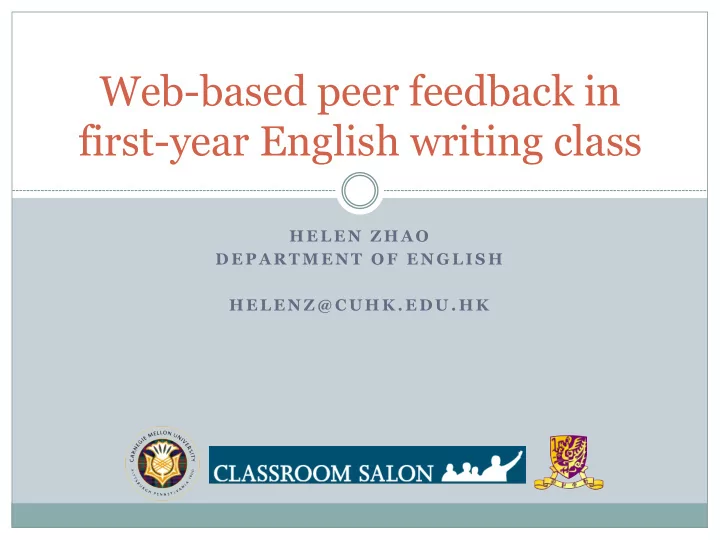

Web-based peer feedback in first-year English writing class H E L E N Z H A O D E P A R T M E N T O F E N G L I S H H E L E N Z @ C U H K . E D U . H K
Traditional Peer Review Pair work or peer response groups In-class or take-home Paper-and-pencil Often unguided or sometimes guided with a worksheet (content, organization, cohesion, style, and grammar) Fill in the worksheet and exchange Optional verbal sharing after exchange It allows students to have at least a reader who helps with detecting more visible and obvious problems in a draft before submitting it to the instructor.
Issues Often times peer review is not as effective as what we want it to be (Leki, 1990, Ts & Ng, 2000). Students tend to respond to surface errors instead of semantic or textual ones. Students have difficulties deciding whether their peer’s comments are valid. Students may not trust their peers’ responses to their writings.
Issues Students often have difficulties in transferring peer feedback to revision. “I think this essay has some problems with its organization. I don’t think it flows well ” à Not good localization of problems à Not enough elaboration of the problem Some students may misinterpret peer review as “peer critique” or even “peer criticism”. à not healthy, supportive classroom dynamics Rely on teachers (heavy workload)
Exploratory Question Can the use of web-based annotation tools help to target the problems identified in the traditional peer review activities?
Methodology Participants: 13 students in the first-year writing course at the Department of English CUHK 8 English majors, 5 ELED students Language background: 9 Cantonese 2 Cantonese and Mandarin bilingual 1 Mandarin 1 Pilipino (near-native English proficiency)
The Writing Class First-year writing course: “Communication Skills for English Majors I” Components: 60% writing, 40% spoken Two writing assignments: 1. Persuasion paper (argumentative) 2. Short story analysis paper (literary analysis) Procedure: 1 st draft à teacher conference à 2 nd draft à salon annotation (a week) à in-class verbal feedback sharing (10 minutes per student) à last draft
The tool: Classroom Salon f
§ Student writer § Student Review 1 § Student Review 2
Data Collection: Instruments Writing drafts Salon annotations Audio-recording of verbal feedback sharing in class Student reflection journals over the semester Audio-recorded semi-structured interviews with all the 13 students in the class Their Michigan English Proficiency Test scores (2 students missing)
Preliminary results Participants’ English proficiencies: Scores Frequency Percent Cumulative Band percent 56 1 9.1 9.1 Borderline/Basic 75, 75, 75, 5 45.5 54.6 Good 76, 77 80 1 9.1 63.7 Very good 88, 88, 2 18.2 90.9 High command 89 95 1 9.1 100 Near-native
Preliminary Findings Overall user experience: Students had a positive experience with salon and the peer review activities structured around it. Students reported that the classroom dynamics supported by salon was positive and collaborative. Students reported that they felt the class was more student-centered rather than teacher-centered. Students reported that they felt they had received sufficient amounts of information from peer review (salon annotation + verbal feedback sharing) that they needed for revision.
Preliminary Findings Students recognized the need of having readers for writing. Students had a better understanding of the rationale of adopting the writing-as-a-process approach in writing instruction. Students could better understand the importance of the requirements of a writing assignment. Students got exposed to different styles of writing. This exposure helped them to reflect on their own writing.
Salon annotation vs. Verbal feedback Salon annotation gave students the space to exhaustively comment on all aspects of writing. Verbal feedback sharing, due to the time pressure, pushed students to shift their focus of comments from grammar to macro-features of writing (organization, logical coherence, clarity of ideas, Logical connection between evidence and arguments, sufficiency of evidence in support of arguments, quotation and paraphrase) There was less amount of grammar comments in the second round of salon annotation in the semester.
Students’ preference of feedback Students preferred feedback on: Clarity of ideas Organization Logical connection between evidence and arguments Sufficiency of evidence in support of arguments Feedback that focused on text description (rather than communicating subjective judgments) Feedback that were agreed by both peer reviewers
Limitations of application Students with higher English proficiency and more review experiences may benefit less than others. Students with lower English proficiency may not be able to be equipped with the metalinguistic knowledge demanded by the practice. More training and scaffolding is needed before asking students to use the tool for peer review. E.g., teach categories of annotations with exemplar comments; limit the number of comments on surface errors to avoid information flooding Course schedule is prolonged due to intensive peer review activities.
Conclusion The peer review activities in the current study enhanced audience awareness and enabled students to see egocentrism in their writings. Students learned more about writing and revision by reading each other’s drafts critically. Their metacognitive awareness of writing was enhanced. Combining salon annotation with in-class verbal feedback sharing pushed students to move away from limited comments on surface errors. They learnt to focus more on large issues in writing.
Acknowledgement Questions and comments? David Kaufer Ananda Gunawardena & Helen Zhao Students who participated in this study helenz@cuhk.edu.hk
Recommend
More recommend